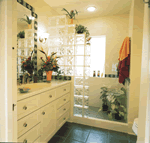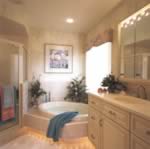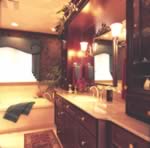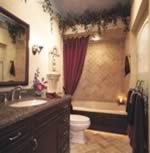Beautiful Places to Start and End the Day
All Photos by Charles Ward Of all the rooms in our homes, kitchens and baths (especially master baths) have changed the most dramatically over the years. Just as the once utilitarian kitchen has become a spacious family gathering place and informal entertaining areas, many of today’s baths have become elegant, luxurious rooms designed to comfort and pamper. We recently spoke with Charles Ward, CKD, Lisa Anderson, CKD, ASID and Megan Warren of Ward’s Kitchens and Baths in Omaha, Nebraska, about some of the essential and extras that go into today’s baths. They highlighted the following considerations when plan master baths.
Of all the rooms in our homes, kitchens and baths (especially master baths) have changed the most dramatically over the years. Just as the once utilitarian kitchen has become a spacious family gathering place and informal entertaining areas, many of today’s baths have become elegant, luxurious rooms designed to comfort and pamper. We recently spoke with Charles Ward, CKD, Lisa Anderson, CKD, ASID and Megan Warren of Ward’s Kitchens and Baths in Omaha, Nebraska, about some of the essential and extras that go into today’s baths. They highlighted the following considerations when plan master baths.
(1) Privacy vs. openness.
 Our fondness of open spaces within the home doesn’t end at the bathroom door. While most of us would prefer that our master baths include compartmented toilets, we also want this room to feel open and airy. In keeping with this, there is a trend to keep showers as open as possible. One way to do so is by using a partial wall composed of glass block and eliminating the shower door altogether. In order to accomplish this, the shower stall must be long enough to contain the spray behind the abbreviated wall. A sure way to minimize the area that needs to be enclosed is to select a showerhead that delivers a “rain shower” straight down. Frameless shower doors are also popular in that they appear less restrictive. If glass block is not to your liking, consider using a heavy glass panel enclosure instead. Glass panels provide the optimum sense of open space (from inside and outside the shower) and require less maintenance than glass block with grout.
Our fondness of open spaces within the home doesn’t end at the bathroom door. While most of us would prefer that our master baths include compartmented toilets, we also want this room to feel open and airy. In keeping with this, there is a trend to keep showers as open as possible. One way to do so is by using a partial wall composed of glass block and eliminating the shower door altogether. In order to accomplish this, the shower stall must be long enough to contain the spray behind the abbreviated wall. A sure way to minimize the area that needs to be enclosed is to select a showerhead that delivers a “rain shower” straight down. Frameless shower doors are also popular in that they appear less restrictive. If glass block is not to your liking, consider using a heavy glass panel enclosure instead. Glass panels provide the optimum sense of open space (from inside and outside the shower) and require less maintenance than glass block with grout.
(2) Soak or spray.
Some of us are tub people. Some of us are shower people. However we choose to come clean, most of us are attracted to whirlpool tubs – or at least the thought of them. Many who have them, however, don’t use them regularly (showers are friendlier to our fast pace). Still, whirlpool tubs can add a significant perceived value to the home. The designers’ general recommendation is to include a whirlpool when it will affect resale value, which is often the case in larger homes. Some homeowners are opting instead for an oversized, walk-in shower, which may include a shower seat and multiple heads. This choice should only be considered if there is at least one tub elsewhere the home. For those who have refined the art of relaxation, home saunas and steam showers are also options that are becoming more common.
(3) Single or double vanities.
 The amount of space required to make ourselves presentable in the morning varies from one person to the next. Most people sharing a single sink can only imagine the luxury of having two. Keep in mind, however, that two sinks means losing counter space and storage space underneath, plus added expense for fixtures and installation. Those trade-offs, however, can be warranted if two people will be using the same space at the same time, or if one of the individuals requires a neater area than the other.
The amount of space required to make ourselves presentable in the morning varies from one person to the next. Most people sharing a single sink can only imagine the luxury of having two. Keep in mind, however, that two sinks means losing counter space and storage space underneath, plus added expense for fixtures and installation. Those trade-offs, however, can be warranted if two people will be using the same space at the same time, or if one of the individuals requires a neater area than the other.
(4) Storage – plan for plenty.
Here’s one thing in life that you can’t have two much of. For some of us, its an over abundance of bath towels. For others, it’s an obsession for bath soaps, makeup cologne hair products and hair appliances. In the worst case scenario, it’s both. In any case, make sure your master bath allows plenty of space for your stuff. Also keep in mind that utility trays or roll-outs, normally used in kitchen cabinets, can offer visibility and convenient access.
(5) Décor – predictable or provocative.
Because master baths are separated from the rest of the home, they can get away with flaunting their own individual style, even if it doesn’t necessarily coordinate with the rest of the home. However, it’s important to keep expensive elements some- what neutral and timeless and add color with wall treatments, fabrics and accessories. White, beige or ivory are the safest colors for tubs, toilets and sinks. Granite and Corian are perennially popular for countertops. Cultured marble is less expensive, and is also often used to create integral counters and bowls. Solid colors are a safer choice than swirls, which tend to look dated. Ceramic tile, the most popular choice for flooring, is available in a myriad of colors, shapes and sizes and can be used to bring the design full circle. Because baths have less area to cover than most other rooms, walls invite special attention, whether it be a faux treatment, a mural (properly sealed), wallpaper, pleasing artwork or even a wall fountain.
(6) Light & Bright.
While nothing lightens a bath’s atmosphere like a window, windows can also present logistical dilemmas. The humidity rules out wood blinds. Curtains can be used in areas away from the shower, but they reduce the amount of natural light coming in. One of the easiest ways to maximize the light source while providing privacy is by using frosted glass or textured glass block. When possible, skylights should be considered to brighten the space with natural light.
(7) Mirror, mirror on the wall.
 With proper planning and attention, minors can easily become one of the focal points of the bath. Plate mirrors can be framed in picture framing or ceramic tiles. A framed mirror over the vanity can tastefully double as the door to a recessed medicine cabinet. In any case, make sure to plan for generous lighting to illuminate those happy “morning faces.”
With proper planning and attention, minors can easily become one of the focal points of the bath. Plate mirrors can be framed in picture framing or ceramic tiles. A framed mirror over the vanity can tastefully double as the door to a recessed medicine cabinet. In any case, make sure to plan for generous lighting to illuminate those happy “morning faces.”
(8) Which wood.
Because baths are smaller areas, it is usually best not to mix the use of woods, as can often be done in larger rooms, such as kitchens. Popular wood choices are maple or cherry in natural, dark or honey finishes. About an equal number of homeowners prefer painted woodwork (in soft neutrals or white).
(9) An array of amenities.
With cathedral ceilings and, the sky really is the limit when it comes to dazzle in the bath. While most ceiling lights are now recessed, track ~ting is still used with tall ceilings. Rope lighting used in molding or atop cabinets and toe ~ting creates added interest at the base of tub enclosures or cabinets.
Decorative fixtures are generally placed over vanities. For an added touch of indulgence, consider a fog-free mirror, heat lamp, heated towel bar or heated floor. Children’s baths require many special features for convenience and safety that also are often included in those for mature homebuyers, including: tempered glass shower doors, grab bars over the tub, lever faucet handles that are easier to control, non- slip floors and towel bars at lower heights. Because powder baths are small, it’s more affordable to make them extra lavish. Special details such as rope trim on cabinets become more noticeable in these small areas. Pedestal sinks present a pleasing, stream- lined look and are more practical here than in other baths where storage is more crucial. The newer above-counter styled sinks (that resemble bowls) can also provide an interesting focal point.
Charles A. Ward, CKD, is owner of Ward’s Kitchen and Baths, Inc., winner of 10 national design awards. Ward and his company have more than 19 years experience specializing in kitchen and bath design, interior design and remodeling. For more information visit: www.wardskb.com.
